scikit-opt
Python实现的群体智能算法 (遗传算法、粒子群优化、模拟退火、蚁群算法、免疫算法、人工鱼群算法的Python实现)
- 文档: https://scikit-opt.github.io/scikit-opt/#/en/
- 文档: https://scikit-opt.github.io/scikit-opt/#/zh/
- 源代码: https://github.com/guofei9987/scikit-opt
- 帮助我们改进scikit-opt https://www.wjx.cn/jq/50964691.aspx
安装
pip install scikit-opt
对于当前开发版本:
git clone git@github.com:guofei9987/scikit-opt.git cd scikit-opt pip install .
特性
特性1:UDF
现在支持UDF(用户自定义函数)!
例如,你刚刚开发了一种新的选择函数。
现在,你的选择函数如下所示:
-> 示例代码:examples/demo_ga_udf.py#s1
# 步骤1:定义你自己的操作符: def selection_tournament(algorithm, tourn_size): FitV = algorithm.FitV sel_index = [] for i in range(algorithm.size_pop): aspirants_index = np.random.choice(range(algorithm.size_pop), size=tourn_size) sel_index.append(max(aspirants_index, key=lambda i: FitV[i])) algorithm.Chrom = algorithm.Chrom[sel_index, :] # 下一代 return algorithm.Chrom
导入并构建遗传算法 -> 示例代码:examples/demo_ga_udf.py#s2
import numpy as np from sko.GA import GA, GA_TSP demo_func = lambda x: x[0] ** 2 + (x[1] - 0.05) ** 2 + (x[2] - 0.5) ** 2 ga = GA(func=demo_func, n_dim=3, size_pop=100, max_iter=500, prob_mut=0.001, lb=[-1, -10, -5], ub=[2, 10, 2], precision=[1e-7, 1e-7, 1])
将你的自定义函数注册到遗传算法中 -> 示例代码:examples/demo_ga_udf.py#s3
ga.register(operator_name='selection', operator=selection_tournament, tourn_size=3)
scikit-opt还提供了一些操作符 -> 示例代码:examples/demo_ga_udf.py#s4
from sko.operators import ranking, selection, crossover, mutation ga.register(operator_name='ranking', operator=ranking.ranking). \ register(operator_name='crossover', operator=crossover.crossover_2point). \ register(operator_name='mutation', operator=mutation.mutation)
现在像往常一样运行遗传算法 -> 示例代码:examples/demo_ga_udf.py#s5
best_x, best_y = ga.run() print('best_x:', best_x, '\n', 'best_y:', best_y)
目前,udf支持遗传算法的
交叉、变异、选择和排序scikit-opt提供了十几种操作符,详见这里
对于高级用户:
-> 示例代码:examples/demo_ga_udf.py#s6
class MyGA(GA): def selection(self, tourn_size=3): FitV = self.FitV sel_index = [] for i in range(self.size_pop): aspirants_index = np.random.choice(range(self.size_pop), size=tourn_size) sel_index.append(max(aspirants_index, key=lambda i: FitV[i])) self.Chrom = self.Chrom[sel_index, :] # 下一代 return self.Chrom ranking = ranking.ranking demo_func = lambda x: x[0] ** 2 + (x[1] - 0.05) ** 2 + (x[2] - 0.5) ** 2 my_ga = MyGA(func=demo_func, n_dim=3, size_pop=100, max_iter=500, lb=[-1, -10, -5], ub=[2, 10, 2], precision=[1e-7, 1e-7, 1]) best_x, best_y = my_ga.run() print('best_x:', best_x, '\n', 'best_y:', best_y)
特性2:继续运行
(0.3.6版本新增) 运行算法10次迭代,然后基于前10次迭代再运行20次迭代:
from sko.GA import GA func = lambda x: x[0] ** 2 ga = GA(func=func, n_dim=1) ga.run(10) ga.run(20)
特性3:4种加速方式
- 向量化
- 多线程
- 多进程
- 缓存
详见 https://github.com/guofei9987/scikit-opt/blob/master/examples/example_function_modes.py
特性4:GPU计算
我们正在开发GPU计算功能,将在1.0.0版本稳定发布。 目前已有可用示例:https://github.com/guofei9987/scikit-opt/blob/master/examples/demo_ga_gpu.py
快速入门
1. 差分进化算法
第1步:定义问题
-> 示例代码:examples/demo_de.py#s1
''' 最小化 f(x1, x2, x3) = x1^2 + x2^2 + x3^2 约束条件: x1*x2 >= 1 x1*x2 <= 5 x2 + x3 = 1 0 <= x1, x2, x3 <= 5 ''' def obj_func(p): x1, x2, x3 = p return x1 ** 2 + x2 ** 2 + x3 ** 2 constraint_eq = [ lambda x: 1 - x[1] - x[2] ] constraint_ueq = [ lambda x: 1 - x[0] * x[1], lambda x: x[0] * x[1] - 5 ]
第2步:执行差分进化算法
-> 示例代码:examples/demo_de.py#s2
from sko.DE import DE de = DE(func=obj_func, n_dim=3, size_pop=50, max_iter=800, lb=[0, 0, 0], ub=[5, 5, 5], constraint_eq=constraint_eq, constraint_ueq=constraint_ueq) best_x, best_y = de.run() print('最优解:', best_x, '\n', '最优值:', best_y)
2. 遗传算法
第1步:定义问题
-> 示例代码:examples/demo_ga.py#s1
import numpy as np def schaffer(p): ''' 该函数有大量局部最小值,具有强烈震荡 全局最小值在(0,0)处,取值为0 https://en.wikipedia.org/wiki/Test_functions_for_optimization ''' x1, x2 = p part1 = np.square(x1) - np.square(x2) part2 = np.square(x1) + np.square(x2) return 0.5 + (np.square(np.sin(part1)) - 0.5) / np.square(1 + 0.001 * part2)
第2步:执行遗传算法
-> 示例代码:examples/demo_ga.py#s2
from sko.GA import GA ga = GA(func=schaffer, n_dim=2, size_pop=50, max_iter=800, prob_mut=0.001, lb=[-1, -1], ub=[1, 1], precision=1e-7) best_x, best_y = ga.run() print('最优解:', best_x, '\n', '最优值:', best_y)
-> 示例代码:examples/demo_ga.py#s3
import pandas as pd import matplotlib.pyplot as plt Y_history = pd.DataFrame(ga.all_history_Y) fig, ax = plt.subplots(2, 1) ax[0].plot(Y_history.index, Y_history.values, '.', color='red') Y_history.min(axis=1).cummin().plot(kind='line') plt.show()

2.2 用于TSP(旅行商问题)的遗传算法
只需导入GA_TSP,它重载了crossover和mutation以解决TSP问题
第1步:定义问题。准备好点的坐标和距离矩阵。
这里我随机生成数据作为演示:
-> 示例代码:examples/demo_ga_tsp.py#s1
import numpy as np from scipy import spatial import matplotlib.pyplot as plt num_points = 50 points_coordinate = np.random.rand(num_points, 2) # 生成点的坐标 distance_matrix = spatial.distance.cdist(points_coordinate, points_coordinate, metric='euclidean') def cal_total_distance(routine): '''目标函数。输入路线,返回总距离。 cal_total_distance(np.arange(num_points)) ''' num_points, = routine.shape return sum([distance_matrix[routine[i % num_points], routine[(i + 1) % num_points]] for i in range(num_points)])
第2步:执行遗传算法
-> 示例代码:examples/demo_ga_tsp.py#s2
from sko.GA import GA_TSP ga_tsp = GA_TSP(func=cal_total_distance, n_dim=num_points, size_pop=50, max_iter=500, prob_mut=1) best_points, best_distance = ga_tsp.run()
第3步:绘制结果:
-> 示例代码:examples/demo_ga_tsp.py#s3
fig, ax = plt.subplots(1, 2) best_points_ = np.concatenate([best_points, [best_points[0]]]) best_points_coordinate = points_coordinate[best_points_, :] ax[0].plot(best_points_coordinate[:, 0], best_points_coordinate[:, 1], 'o-r') ax[1].plot(ga_tsp.generation_best_Y) plt.show()

3. PSO(��粒子群优化)
3.1 粒子群优化算法(PSO)
步骤1:定义你的问题: -> 示例代码:examples/demo_pso.py#s1
def demo_func(x): x1, x2, x3 = x return x1 ** 2 + (x2 - 0.05) ** 2 + x3 ** 2
步骤2:执行PSO -> 示例代码:examples/demo_pso.py#s2
from sko.PSO import PSO pso = PSO(func=demo_func, n_dim=3, pop=40, max_iter=150, lb=[0, -1, 0.5], ub=[1, 1, 1], w=0.8, c1=0.5, c2=0.5) pso.run() print('最优x为', pso.gbest_x, '最优y为', pso.gbest_y)
步骤3:绘制结果 -> 示例代码:examples/demo_pso.py#s3
import matplotlib.pyplot as plt plt.plot(pso.gbest_y_hist) plt.show()
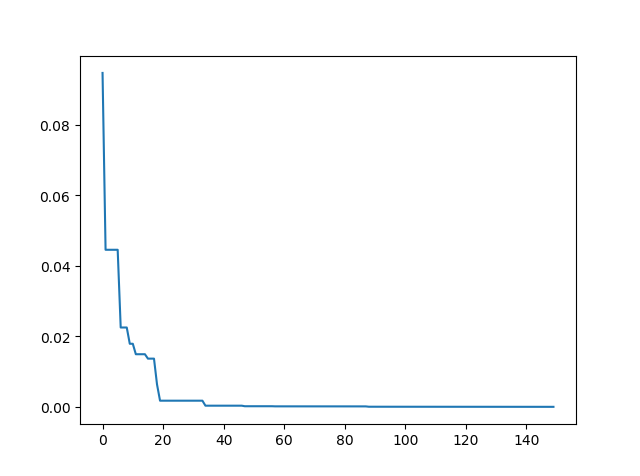
3.2 带非线性约束的PSO
如果你需要非线性约束,比如 (x[0] - 1) ** 2 + (x[1] - 0) ** 2 - 0.5 ** 2<=0
代码如下:
constraint_ueq = ( lambda x: (x[0] - 1) ** 2 + (x[1] - 0) ** 2 - 0.5 ** 2 , ) pso = PSO(func=demo_func, n_dim=2, pop=40, max_iter=max_iter, lb=[-2, -2], ub=[2, 2] , constraint_ueq=constraint_ueq)
注意,你可以添加多个非线性约束。只需将它们添加到 constraint_ueq 中
此外,我们还有一个动画:
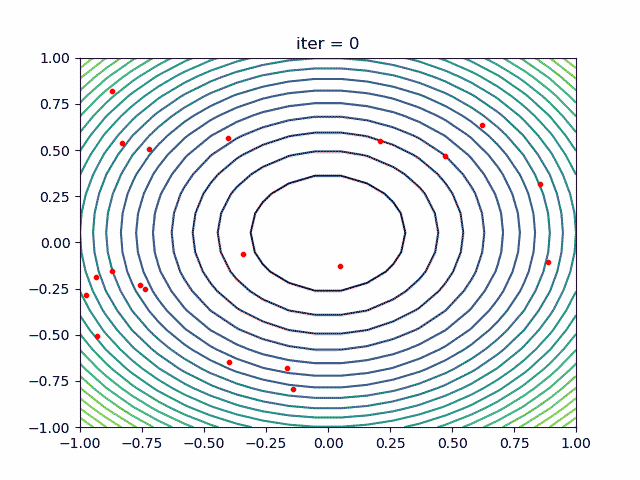 ↑查看 examples/demo_pso_ani.py
↑查看 examples/demo_pso_ani.py
4. 模拟退火算法(SA)
4.1 用于多元函数的SA
步骤1:定义你的问题 -> 示例代码:examples/demo_sa.py#s1
demo_func = lambda x: x[0] ** 2 + (x[1] - 0.05) ** 2 + x[2] ** 2
步骤2:执行SA -> 示例代码:examples/demo_sa.py#s2
from sko.SA import SA sa = SA(func=demo_func, x0=[1, 1, 1], T_max=1, T_min=1e-9, L=300, max_stay_counter=150) best_x, best_y = sa.run() print('最优x:', best_x, '最优y', best_y)
步骤3:绘制结果 -> 示例代码:examples/demo_sa.py#s3
import matplotlib.pyplot as plt import pandas as pd plt.plot(pd.DataFrame(sa.best_y_history).cummin(axis=0)) plt.show()
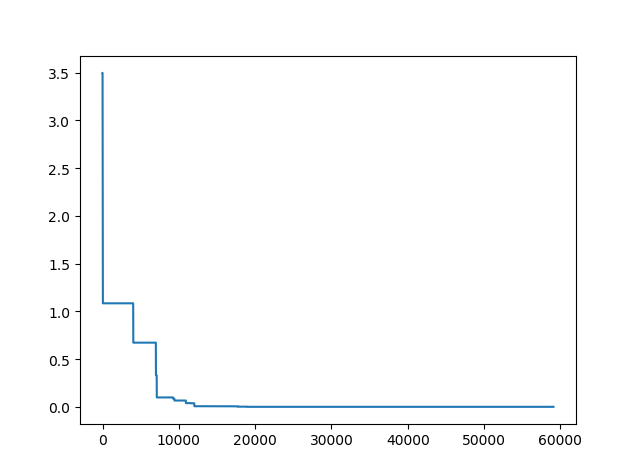
此外,scikit-opt提供了3种类型的模拟退火算法:快速退火、玻尔兹曼退火和柯西退火。查看更多SA信息
4.2 用于TSP的SA
步骤1:哦,是的,定义你的问题。太无聊了,就不复制这一步了。
步骤2:对TSP执行SA -> 示例代码:examples/demo_sa_tsp.py#s2
from sko.SA import SA_TSP sa_tsp = SA_TSP(func=cal_total_distance, x0=range(num_points), T_max=100, T_min=1, L=10 * num_points) best_points, best_distance = sa_tsp.run() print(best_points, best_distance, cal_total_distance(best_points))
步骤3:绘制结果 -> 示例代码:examples/demo_sa_tsp.py#s3
from matplotlib.ticker import FormatStrFormatter fig, ax = plt.subplots(1, 2) best_points_ = np.concatenate([best_points, [best_points[0]]]) best_points_coordinate = points_coordinate[best_points_, :] ax[0].plot(sa_tsp.best_y_history) ax[0].set_xlabel("迭代次数") ax[0].set_ylabel("距离") ax[1].plot(best_points_coordinate[:, 0], best_points_coordinate[:, 1], marker='o', markerfacecolor='b', color='c', linestyle='-') ax[1].xaxis.set_major_formatter(FormatStrFormatter('%.3f')) ax[1].yaxis.set_major_formatter(FormatStrFormatter('%.3f')) ax[1].set_xlabel("经度") ax[1].set_ylabel("纬度") plt.show()
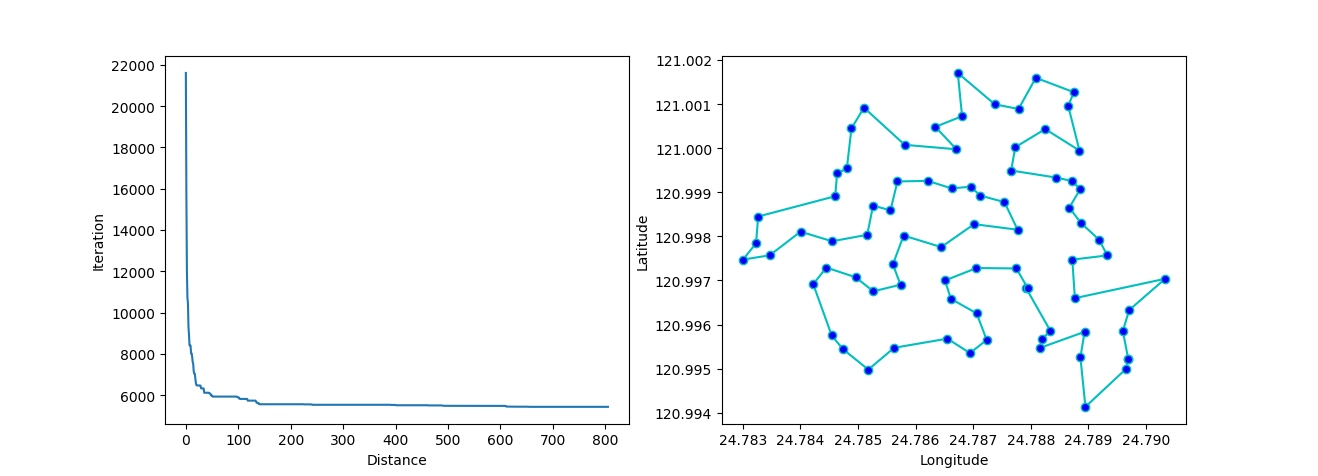
更多:绘制动画:
5. 用于TSP的蚁群算法(ACA)
-> 示例代码:examples/demo_aca_tsp.py#s2
from sko.ACA import ACA_TSP aca = ACA_TSP(func=cal_total_distance, n_dim=num_points, size_pop=50, max_iter=200, distance_matrix=distance_matrix) best_x, best_y = aca.run()
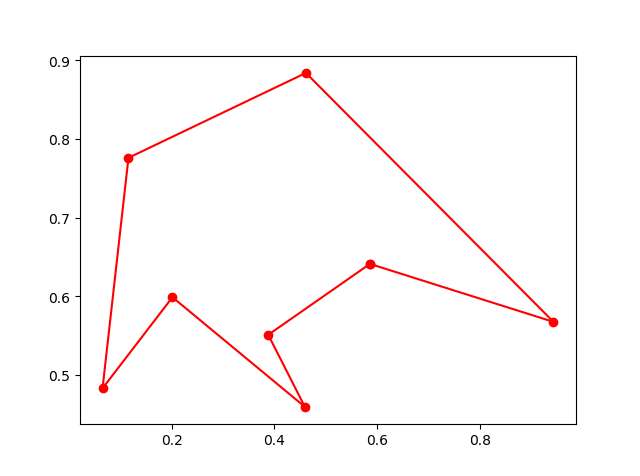
6. 免疫算法(IA)
-> 示例代码:examples/demo_ia.py#s2
from sko.IA import IA_TSP ia_tsp = IA_TSP(func=cal_total_distance, n_dim=num_points, size_pop=500, max_iter=800, prob_mut=0.2, T=0.7, alpha=0.95) best_points, best_distance = ia_tsp.run() print('最佳路线:', best_points, '最短距离:', best_distance)
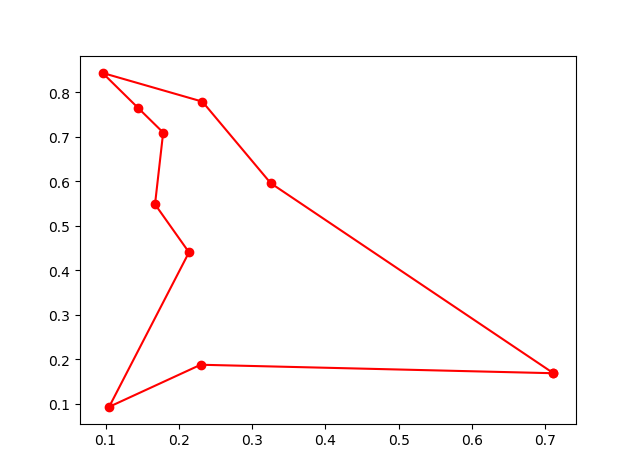
7. 人工鱼群算法(AFSA)
-> 示例�代码:examples/demo_afsa.py#s1
def func(x): x1, x2 = x return 1 / x1 ** 2 + x1 ** 2 + 1 / x2 ** 2 + x2 ** 2 from sko.AFSA import AFSA afsa = AFSA(func, n_dim=2, size_pop=50, max_iter=300, max_try_num=100, step=0.5, visual=0.3, q=0.98, delta=0.5) best_x, best_y = afsa.run() print(best_x, best_y)
使用scikit-opt的项目
- Yu, J., He, Y., Yan, Q., & Kang, X. (2021). SpecView:基于奇异谱变换的恶意软件谱可视化框架。IEEE信息取证与安全交易,16,5093-5107。
- Zhen, H., Zhai, H., Ma, W., Zhao, L., Weng, Y., Xu, Y., ... & He, X. (2021). 基于强化学习的最优潮流解生成器的设计与测试。能源报告。
- Heinrich, K., Zschech, P., Janiesch, C., & Bonin, M. (2021). 过程数据属性很重要:引入门控卷积神经网络(GCNN)和键值预测注意力网络(KVP)用于深度学习的下一事件预测。决策支持系统,143,113494。
- Tang, H. K., & Goh, S. K. (2021). 一种受易经哲学启发的新型非群体元启发式优化器。arXiv预印本 arXiv:2104.08564。
- Wu, G., Li, L., Li, X., Chen, Y., Chen, Z., Qiao, B., ... & Xia, L. (2021). 基于图嵌入的实时社交事件匹配用于EBSN推荐。万维网,1-22。
- Pan, X., Zhang, Z., Zhang, H., Wen, Z., Ye, W., Yang, Y., ... & Zhao, X. (2021). 基于注意力机制和双损失函数的循环神经网络的快速稳健混合气体识别和浓度检测算法。传感器与执行器B:化学,342,129982。
- Castella Balcell, M. (2021). WindCrete浮式海上风力发电机组定位系统的优化。
- Zhai, B., Wang, Y., Wang, W., & Wu, B. (2021). 雾天条件下高速公路路段最优可变限速控制策略。arXiv预印本 arXiv:2107.14406。
- Yap, X. H. (2021). 局部线性数据的多标签分类:应用于化学毒性预测。
- Gebhard, L. (2021). 使用蚁群优化算法的低压电网扩展规划。
- Ma, X., Zhou, H., & Li, Z. (2021). 氢能和电力系统相互依存关系的最优设计。IEEE工业应用交易。
- de Curso, T. D. C. (2021). Johansen-Ledoit-Sornette金融泡沫模型研究。
- Wu, T., Liu, J., Liu, J., Huang, Z., Wu, H., Zhang, C., ... & Zhang, G. (2021). 用于无人机辅助无线传感器网络中AoI最优轨迹规划的新型人工智能框架。IEEE无线通信交易。
- Liu, H., Wen, Z., & Cai, W. (2021年8月). FastPSO:面向GPU上高效群体智能算法。第50届并行处理国际会议(第1-10页)。
- Mahbub, R. (2020). 求解TSP的算法和优化技术。
- Li, J., Chen, T., Lim, K., Chen, L., Khan, S. A., Xie, J., & Wang, X. (2019). 深度学习加速的金纳米簇合成。先进智能系统,1(3),1900029。
编辑推荐精选


Vora
免费创建高清无水印Sora视频
Vora是一个免费创建高清无水印Sora视频的AI工具


Refly.AI
最适合小白的AI自动化工作流平台
无需编码,轻松生成可复用、可变现的AI自动化工作流


酷表ChatExcel
大模型驱动的Excel数据处理工具
基于大模型交互的表格处理系统,允许用户通过对话方式完成数据整理和可视化分析。系统采用机器学习算法解析用户指令,自动执行排序、公式计算和数据透视等操作,支持多种文件格式导入导出。数据处理响应速度保持在0.8秒以内,支持超过100万行数据的即时分析。


TRAE编程
AI辅助编程,代码自动修复
Trae是一种自适应的集成开发环境(IDE),通过自动化和多元协作改变开发流程。利用Trae,团队能够更快速、精确地编写和部署代码,从而提高编程效率和项目交付速度。Trae具备上下文感知和代码自动完成功能,是提�升开发效率的理想工具。


AIWritePaper论文写作
AI论文写作指导平台
AIWritePaper论文写作是一站式AI论文写作辅助工具,简化了选题、文献��检索至论文撰写的整个过程。通过简单设定,平台可快速生成高质量论文大纲和全文,配合图表、参考文献等一应俱全,同时提供开题报告和答辩PPT等增值服务,保障数据安全,有效提升写作效率和论文质量。


博思AIPPT
AI一键生成PPT,就用博思AIPPT!
博思AIPPT,新一代的AI生成PPT平台,支持智能生成PPT、AI美化PPT、文本&链接生成PPT、导入Word/PDF/Markdown文档生成PPT等,内置海量精美PPT模板,涵盖商务、教育、科技等不同风格,同时针对每个页面提供多种版式,一键自适应切换,完美适配各种办公场景。


潮际好麦
AI赋能电商视觉革命,一站式智能商拍平台
潮际好麦深耕服装行业,是国内AI试衣效果最好的软件。使用先进AIGC能力为电商卖家批量提供优质的、低成本的商拍图。合作品牌有Shein、Lazada、安踏、百丽等65个国内外头部品牌,以及国内10万+淘宝、天猫、京东等主流平台的品牌商家,为卖家节省将近85%的出图成本,提升约3倍出图效率,让品牌能够快速上架。


iTerms
企业专属的AI法律顾问
iTerms是法大大集团旗下法律子品牌,基于最先进的大语言模型(LLM)、专业的法律知识库和强大的智能体架构,帮助企业扫清合规障碍,筑牢风控防线,成为您企业专属的AI法律顾问。


SimilarWeb流量提升
稳定高效的流量提升解决方案,助力品牌曝光
稳定高效的流量提升解决方案,助力品牌曝光


Sora2视频免费生成
最新版Sora2模型免费使用,一键生成无水印视频
最新版Sora2模型免费使用,一键生成无水印视频
推荐工具精选
AI云服务特惠
懂AI专属折扣关注微信公众号
最新AI工具、AI资讯
独家AI资源、AI项目落地

微信扫一扫关注公众号




 ↑查看
↑查看 



